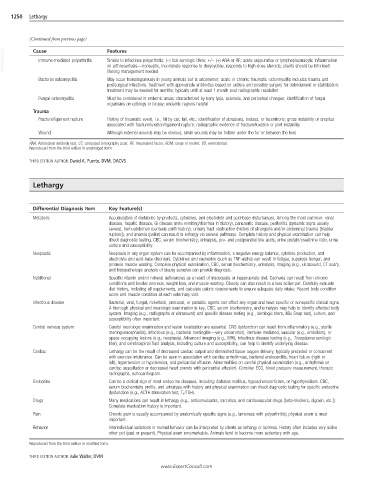Page 2506 - Cote clinical veterinary advisor dogs and cats 4th
P. 2506
1250 Lethargy
(Continued from previous page)
VetBooks.ir Cause Features
Similar to infectious polyarthritis; (−) tick serologic titers; +/− (+) ANA or RF; acute suppurative or lymphoplasmacytic inflammation
Immune-mediated polyarthritis
on arthrocentesis—nonseptic, incomplete response to doxycycline, responds to high-dose steroids; clients should be informed
Bacterial osteomyelitis lifelong management needed
May occur hematogenously in young animals but is uncommon; acute or chronic traumatic osteomyelitis includes trauma and
postsurgical infections, treatment with appropriate antibiotics based on culture and possibly surgery for debridement or stabilization;
treatment may be needed for months; typically until at least 1 month post radiographic resolution
Fungal osteomyelitis Must be considered in endemic areas; characterized by bony lysis, sclerosis, and periosteal changes; identification of fungal
organisms on cytology or biopsy; endemic regions helpful
Trauma
Fracture/ligament rupture History of traumatic event, i.e., hit by car, fall, etc.; identification of abrasions, bruises, or lacerations; gross instability or crepitus
associated with fracture/luxation/ligament rupture; radiographic evidence of fracture/luxation or joint instability
Wound Although external wounds may be obvious, small wounds may be hidden under the fur or between the toes
ANA, Antinuclear antibody test; CT, computed tomography scan; RF, rheumatoid factor; ROM, range of motion; VD, ventrodorsal.
Reproduced from the third edition in unabridged form.
THIRD EDITION AUTHOR: David A. Puerto, DVM, DACVS
Lethargy
Differential Diagnosis Item Key Feature(s)
Metabolic Accumulation of metabolic by-products, cytokines, and electrolyte and acid-base disturbances. Among the most common: renal
disease, hepatic disease, GI disease (note vomiting/diarrhea in history), pancreatic disease, peritonitis (systemic signs usually
severe), hemoabdomen (centesis confirmatory), urinary tract obstruction (history of stranguria and/or abdominal trauma [bladder
rupture]), and anemia (pallor) can result in lethargy via several pathways. Complete history and physical examination can help
direct diagnostic testing. CBC, serum biochemistry, urinalysis, pre- and postprandial bile acids, urine protein/creatinine ratio, urine
culture and susceptibility.
Neoplastic Neoplasia in any organ system can be accompanied by inflammation, a negative energy balance, cytokine production, and
electrolyte and acid-base disorders. Cytokines and cachexins (such as TNF-alpha) can result in fatigue, suppress hunger, and
promote muscle wasting. Complete physical examination, CBC, serum biochemistry, urinalysis, imaging (e.g., ultrasound, CT scan),
and histopathologic analysis of biopsy samples can provide diagnosis.
Nutritional Specific vitamin and/or mineral deficiencies as a result of inadequate or inappropriate diet. Cachexia can result from chronic
conditions and involve anorexia, weight loss, and muscle wasting. Obesity can also result in a less active pet. Carefully evaluate
diet history, including all supplements, and calculate caloric requirements to ensure adequate daily intake. Record body condition
score and muscle condition at each veterinary visit.
Infectious disease Bacterial, viral, fungal, rickettsial, protozoal, or parasitic agents can affect any organ and have specific or nonspecific clinical signs.
A thorough physical and neurologic examination is key. CBC, serum biochemistry, and urinalysis may help to identify affected body
system. Imaging (e.g., radiographs or ultrasound) and specific disease testing (e.g., serologic titers, 4Dx Snap test), culture, and
susceptibility often important.
Central nervous system Careful neurologic examination and lesion localization are essential. CNS dysfunction can result from inflammatory (e.g., sterile
meningoencephalitis), infectious (e.g., bacterial meningitis—very uncommon), immune-mediated, vascular (e.g., embolism), or
space-occupying lesions (e.g., neoplasia). Advanced imaging (e.g., MRI), infectious disease testing (e.g., Toxoplasma serologic
titer), and cerebrospinal fluid analysis, including culture and susceptibility, can help to identify underlying disease.
Cardiac Lethargy can be the result of decreased cardiac output and diminished tissue oxygen delivery; typically preceded or concurrent
with exercise intolerance. Can be seen in association with cardiac arrhythmias, bacterial endocarditis, heart failure (right or
left), hypertension or hypotension, and pericardial effusion. Abnormalities on careful physical examination (e.g., arrhythmia on
cardiac auscultation or decreased heart sounds with pericardial effusion). Consider ECG, blood pressure measurement, thoracic
radiographs, echocardiogram.
Endocrine Can be a clinical sign of most endocrine diseases, including diabetes mellitus, hypoadrenocorticism, or hypothyroidism. CBC,
serum biochemistry profile, and urinalysis with history and physical examination can direct diagnostic testing for specific endocrine
dysfunction (e.g., ACTH stimulation test, T 4/TSH).
Drugs Many medications can result in lethargy (e.g., anticonvulsants, narcotics, and cardiovascular drugs [beta-blockers, digoxin, etc.]).
Complete medication history is important.
Pain Chronic pain is usually accompanied by anatomically specific signs (e.g., lameness with polyarthritis); physical exam is most
important.
Behavior Interindividual variations in normal behavior can be interpreted by clients as lethargy or laziness. History often includes very active
other pet (past or present). Physical exam unremarkable. Animals tend to become more sedentary with age.
Reproduced from the third edition in modified form.
THIRD EDITION AUTHOR: Julie Walter, DVM
www.ExpertConsult.com

